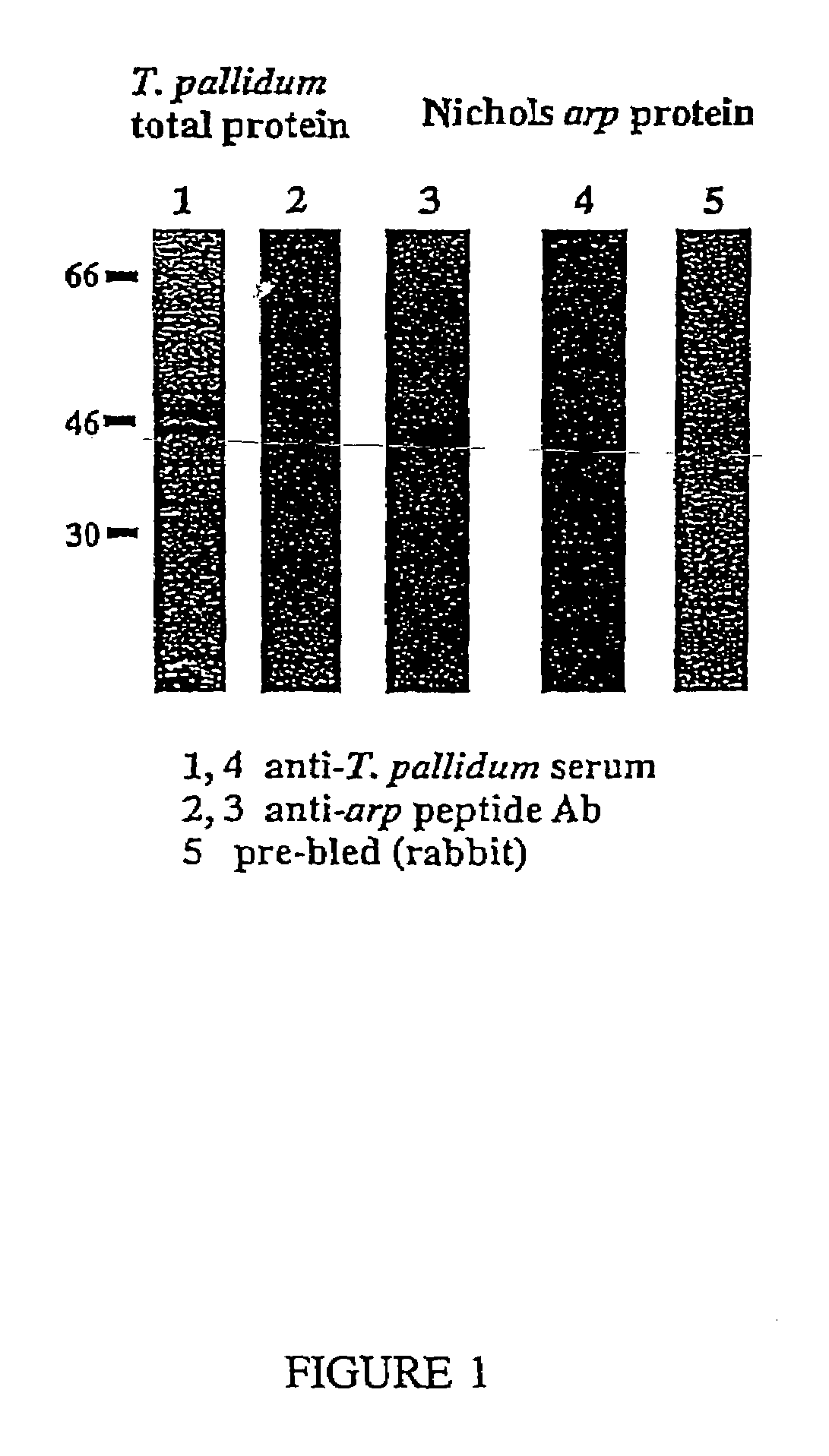Compositions and methods for detecting Treponema pallidum
a technology of treponema pallidum and compositions, applied in the field of microbiology and immunology, can solve the problems of affecting many organs, affecting the quality of life of patients, so as to achieve the effect of preventing the development of syphilis
- Summary
- Abstract
- Description
- Claims
- Application Information
AI Technical Summary
Benefits of technology
Problems solved by technology
Method used
Image
Examples
example 1
Characteristics of the Acidic Repeat Protein
[0165]Genes coding for the acidic repeat proteins from T. pallidum(Nichols strain, CDC-1 strain, CDC-2 strain and Bosnia strain) were cloned. The nucleotide sequences are set forth in SEQ ID NOs: 1 (GenBank Accession No. AF015824), 3, 5, 19 (GenBank Accession No. AF411124), 21 (GenBank Accession No. AF411126), 23 (GenBank Accession No. AF342806), and 25 (GenBank Accession No. AF342807). The arp protein of the Nichols strain was predicted to be 59.4 kD. The protein is characterized by a transmembrane domain, a hydrophobic domain (Q26 to V60) at the N-terminus that could span the cytoplasmic membrane, a sequence of four alanines (A45 to A48), which could serve as a potential signal peptidase I processing site, and 14 almost identical repeats (see FIG. 2) of a 20 amino acid sequence. The putative protein is composed of 18.1% glutamic acids (86 of 432 amino acids).
[0166]The top portion of FIG. 2 represents the hydrophobicity plot of the protei...
example 2
Potential Usages of arp Protein in Diagnosis of Syphilis
[0167]The following studies were directed to further characterize the arp protein with emphasis on the repeat region of immunogenic peptides. The newly identified immunogenic peptides served as targets for constructing immuno diagnostic kits having improved and superior sensitivity.
[0168]Initially, after discovering the arp protein's hydrophobicity plot and its antigenic index as predicted from its protein sequence, peptide fragments from the repeat region of the protein were prepared and used to immunize rabbits. Sera from peptide-immunized rabbits recognized the expressed recombinant protein from an arp gene-containing plasmid. In addition, sera from treponemal infected rabbits also recognized this recombinant protein. (Western blot analyses shown in FIG. 1: Lane 1=total T. pallidum protein identified by anti-T. pallidum serum; Lane 2=anti-peptide [1,2,3] sera failed to identify arp in total T. pallidum protein extracts; Lane...
example 3
Immune Response Toward Peptides of T. pallidum Repeat Protein
[0169]Peptides designed from different regions of the arp protein were used (see Table 2). Syphilitic human sera were used in an ELISA assay to determine the reactivity toward these peptide fragments. The syphilitic sera were either rapid plasma reagent (RPR) positive or negative (RPR+ or RPR−) according to commercial RPR test kits. It was discovered that most of the RPR+ sera reacted with arp peptides 3, 7 and 9 vigorously, whereas none of the RPR− sera reacted with any of the peptides. Reactivity was detected at 1:100 dilution despite that most commercial ELISA kits require a dilution of 1:20 to detect reaction.
[0170]Other peptides (peptide 1–12, excluding 3, 7 and 9) were derived either from the N or C terminal ends of arp protein or from type I or III repeats. Immunogenic reactivity was found to be specific in some peptides to the amino acid sequence DVPK. The results of this study are provided in FIG. 3.
[0171]
TABLE 2P...
PUM
| Property | Measurement | Unit |
|---|---|---|
| temperature | aaaaa | aaaaa |
| temperature | aaaaa | aaaaa |
| temperature | aaaaa | aaaaa |
Abstract
Description
Claims
Application Information
 Login to View More
Login to View More - R&D
- Intellectual Property
- Life Sciences
- Materials
- Tech Scout
- Unparalleled Data Quality
- Higher Quality Content
- 60% Fewer Hallucinations
Browse by: Latest US Patents, China's latest patents, Technical Efficacy Thesaurus, Application Domain, Technology Topic, Popular Technical Reports.
© 2025 PatSnap. All rights reserved.Legal|Privacy policy|Modern Slavery Act Transparency Statement|Sitemap|About US| Contact US: help@patsnap.com



